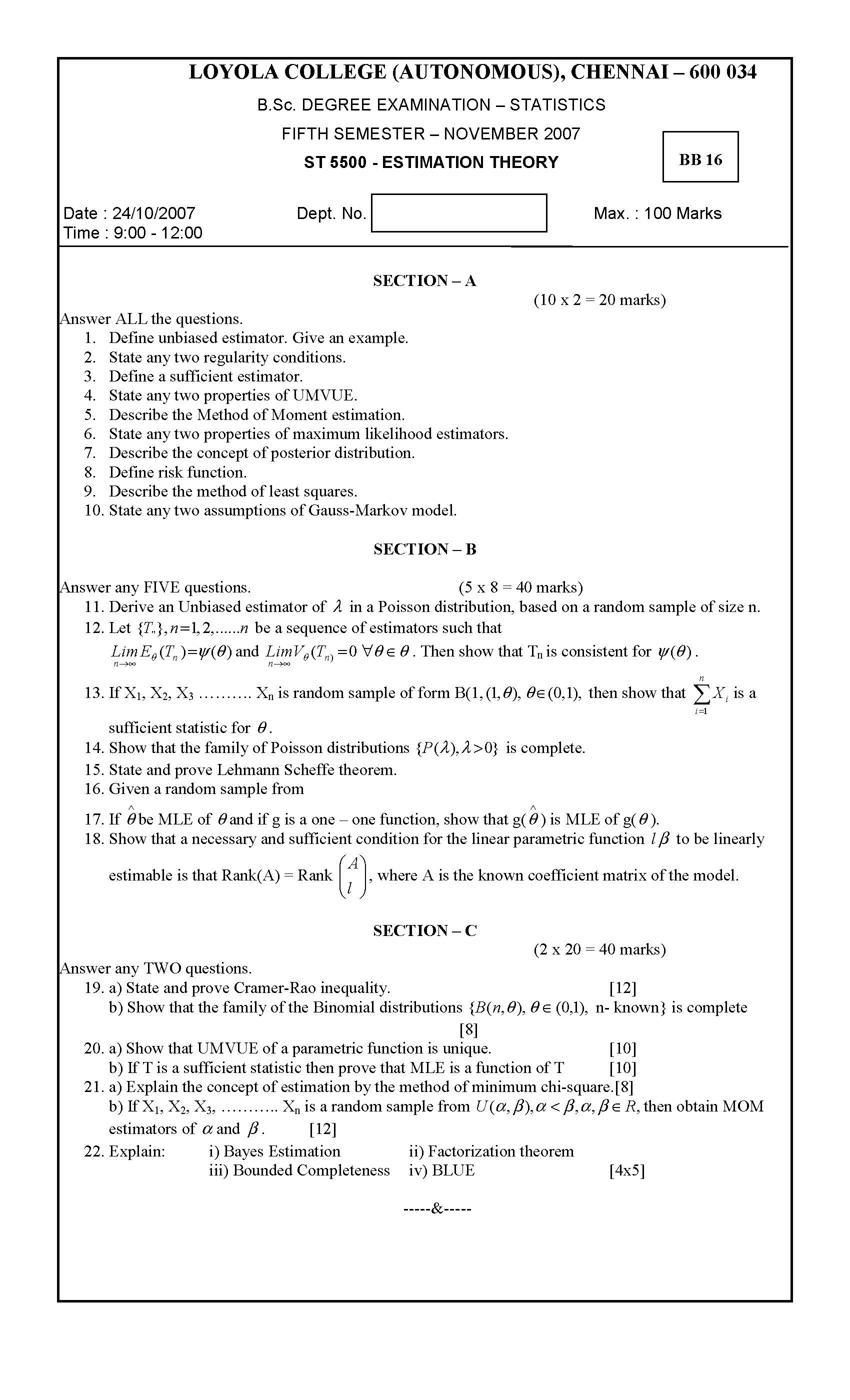LOYOLA COLLEGE (AUTONOMOUS), CHENNAI –600 034
M.Sc., DEGREE EXAMINATION – STATISTICS
SECOND SEMESTER – APRIL 2004
ST 2801 – ESTIMATION THEORY
05.04.2004 Max:100 marks
1.00 – 4.00
SECTION – A
Answer ALL the questions (10 ´ 2 = 20 marks)
- What is the problem of point estimation?
- Show that UMVUE of a given parametric function is unique almost surely.
- Define QA – optimality criterion.
- Let X ~ N ( 0, s2), s > 0. Find a minimal sufficient statistic.
- Classify the following as location none of the two:
- a) BVN (0,0, q, q, 1/2) b) BVN (q, 0, 1, 1, 0.6).
- State Rao-Blackwell theorem.
- Define Exponential family.
- Let X ~ B (n, p), n = 2, 3 and p = . Obtain MLE of (n, p) based on X.
- Define scale equivariant estimator.
- Explain Minimax estimation.
SECTION – B
Answer any FIVE questions (5 ´ 8 = 40 marks)
- Find the Jackknified estimator of m2 in the case of f(x) = , x ≥ m; m Î
- State and establish Basu’s theorem.
- Let X1, X2, …, Xn be a random sample from N (m, s2), m Î R, s > 0. Find UMRUE of
(m, m/s) with respect to any loss function which is convex in its second argument.
- Let X1, X2,…, Xn be iid U (q – , q + ), q Î Find minimal sufficient statistic and examine whether it is boundedly complete.
- Given a random sample of size n from N (m, s2), mÎR, s > 0, find Cramer – Rao lower bound for estimating ( m/s2). Compare it with the variance of UMVUE.
- State and establish the invariance property of CAN estimator.
- Given a random sample from a location family with the location parameter x, show that is MREE of with respect to any invariant loss function, where dO is an LEE, = and * minimizes Eo { P (½with respect to .
- Let X ~ N (q, 1), qÎ Find Bayes estimator of q with respect to squared error loss if the prior of q is N (0, 1).
SECTION – C
Answer any TWO questions (2 ´ 20 = 40 marks)
- a) Give an example for each of the following:
- i) Ug is empty ii) Ug is singleton.
- b) Let X be DU {1,2,…, N}, N = 1,2,3,4,… . Find QA – optimal estimator of (N, N2).
(12+8)
- a) Show that a vector unbiased estimator is D – optimal if and only if each of its
components is a UMVUE.
- b) State and establish Lehmann – Scheffe theorem. (12+8)
- a) Let X1, X2, …, Xn be iid N (0, ), Find MREE of r with respect to
standardized squared error loss.
- b) Let (Xi , Yi), i = 1,2, …, n be a random sample from ACBVE distribution with pdf.
f(x,y) = {(2a+b) (a + b) / 2} exp {-a(x+y) – b max. (x,y)}, x, y > 0.
Find i) MLE of ( a, b) and (ii) examine whether the MLE is consistent. (8+8+4)
- Write short notes on:-
- Jackknifing method.
- Fisher information
- Location – scale family (10+5+5)

